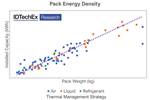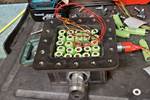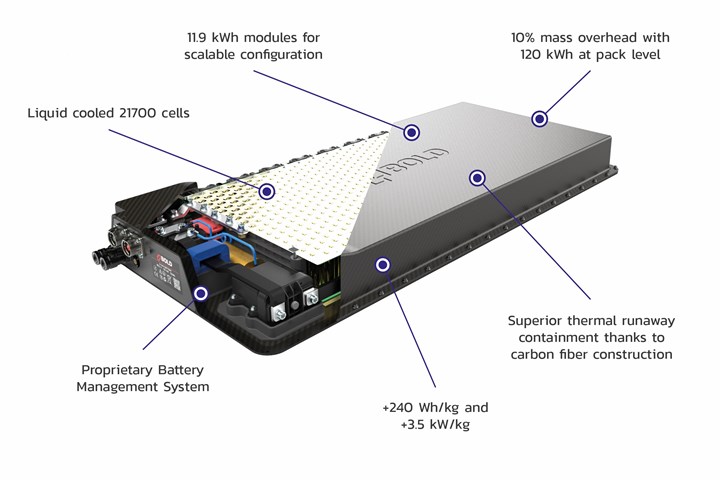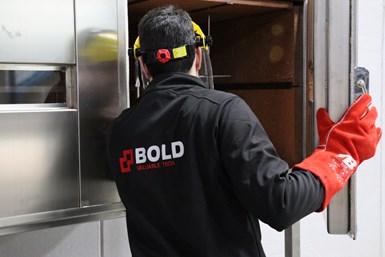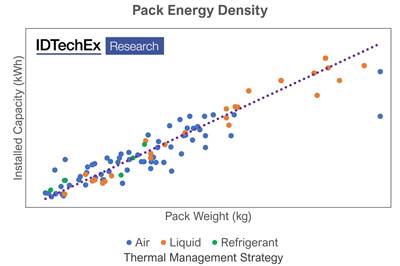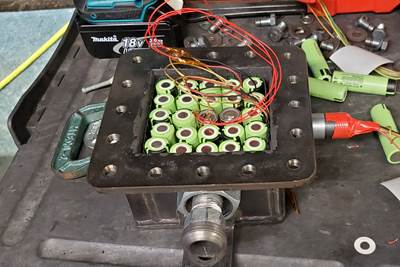Share
Read Next
Battery enclosures house battery cells and can be designed to help prevent and contain a thermal runaway event. Photo Credit, all images: Bold Valuable Technology
The most significant threat to a battery is thermal runaway. Thus, optimizing the thermal performance of battery enclosures to not only prevent the onset of thermal runaway, but also mitigate its propagation throughout the battery pack, is critical.
Thermal runaway occurs, when a defect — such as overcharge or overtemperature, amongst others — causes a cell to generate temperature at a higher rate than what can be dissipated. This increased temperature triggers exothermic chemical reactions within the cell, which release heat and, in turn, fuel further exothermic reactions. This leads to a chain reaction that spreads to neighboring cells, often resulting in a fire and complete destruction of the battery — as well as potential destruction to the vehicle as well, depending on its severity.
To help prevent and contain a thermal runaway event, compression pads, module enclosures and battery enclosures are incorporated within the battery design. Compression pads are placed between each battery cell to prevent thermal runaway in one cell from propagating to neighboring cells. These cells are then grouped together and housed in module enclosures to avoid thermal runaway spreading to other modules. Finally, these modules are housed within a battery enclosure that aims to protect the rest of the vehicle from the effects of a thermal runaway.
The specific design, shape and size of electric vehicle (EV) battery enclosures vary significantly depending on the types of cells used, the cooling requirements, the distribution of modules and the application — such as the type of vehicle and environment in which it will potentially work. However, in general, module enclosures consist of: (1) an enclosure base (2) an enclosure case (3) a connection plate that joins the inner and outer components and (4) venting valves to enable pressure equalization or the release of gas during a thermal runaway.
Materials
Materials used for battery enclosures need to have high thermal performance, good mechanical properties and also be lightweight. Traditionally, aluminum and steel have been the materials of choice due to their high heat resistance and suitability for mass production. However, the heavier weight of metals is a significant disadvantage, particularly for hybrid and EVs, where lower vehicle mass means higher energy density and extended vehicle range. Currently, the mass of the battery can comprise up to 50% of the vehicle’s weight.
Composites on the other hand, offer a lightweight alternative and have the potential to outperform metals in many ways, but are often overlooked due to their reputation for high complexity and cost. For example, Bold Valuable Technology (Barcelona, Spain) recently helped to develop a carbon fiber-reinforced polymer (CFRP) enclosure for a motorsport customer. The original enclosure was made of aluminum and weighed 6.7 kilograms (14.8 pounds). The CFRP alternative was 91% lighter, weighing in at only 616 grams (1.35 pounds).
To achieve the high thermal and mechanical performance required from a battery enclosure, carbon fiber thermoset prepregs are predominantly used. The carbon fibers provide strength and stiffness to the enclosure and are pre-impregnated with high-grade resin systems such as epoxy. However, the manual layup process typically used with these prepregs, along with the long cure times and historical need for an autoclave, has restricted prepreg battery enclosures to low production volumes.
Although typical engineering thermoplastic resins used in automotive applications (e.g., polyamide/nylon, polypropylene) offer fast molding times, and thus are easier to mass produce, their limited behavior at higher temperatures makes them unsuitable for battery enclosures. Furthermore, to achieve the required mechanical performance, wall thicknesses must be increased, which increases weight.
As a result, Bold is currently exploring new material concepts that can achieve the high performance of thermoset prepregs as well as the manufacturability of thermoplastics. One such material option is polycarbonate-based thermoplastics with glass fiber reinforcement that can be used in standard injection molding processes.
Bold uses Hypermesh with Optistruct software to perform FEA simulations of anisotropic composites for battery enclosures.
Another advantage of composites is the ability to optimize the direction of the fibers to satisfy the specific load requirements of each battery enclosure. Finite element analysis (FEA) is heavily used in the design process to determine the direction of fibers and the quantity of plies required to achieve enclosures with high stiffness and strength while remaining lightweight.
However, the isotropic properties of metals still provide some benefits to battery enclosures and are often used around bolting points. Where one part of the enclosure is clamped to another, metallic inserts usually made from aluminum or titanium can be incorporated into the laminate to provide additional strength and stiffness at these specific locations.
Electrical Insulation
When developing battery enclosures, electrical insulation is another consideration. Carbon fiber is conductive and so glass fiber plies are integrated into the laminate to electrically insulate specific electronic components.
One of the tests for the UL94 flammability standard subjects material to a flame for specific durations of time.
To define the number of layers necessary, Bold tested the dielectric strength of a variety of glass fiber samples. Other materials used are Kevlar, Zylon and Dyneema, which are much lighter but are only used in conventional applications because they have a glass transition temperature (Tg) lower than that of glass fiber. Each sample used a different type of resin matrix and had a different number of plies. Samples were placed between copper plates and a voltage was applied. The amount of electrical current (measured in amperes) that the material allowed to go through was then used to determine the resistance of the material. These tests showed that the type of resin — not the number of plies — determined the dielectric strength. Consequently, only a few plies of glass fiber are required within the carbon fiber laminate to electrically insulate the enclosure effectively.
Certification
To guarantee the thermal performance of batteries and battery enclosures, a variety of safety tests and standards have to be passed successfully before a battery can be certified for use. The first standard is UN38.8, which certifies the safety of lithium batteries during transportation. This involves eight tests, including altitude simulation, thermal testing, vibration testing, shock testing, external short circuit, impact and crush, overcharge and forced discharge. Batteries also need to be certified according to ECE R100 REV2, which specifies the necessary tests that must be performed on lithium batteries installed in four-wheel EVs for the transport of people or goods. In the case of aviation, other standards like DO311A and DO160G must be considered.
Regarding the battery enclosure, the composite materials need to satisfy the UL94 standard for safety of flammability. This involves several surface, vertical and horizontal burn tests, where a controlled flame is applied to the material numerous times for specific periods. The duration of time the material continues to burn once the flame is removed, and the amount of evidence of burn-through or flaming drips, determines whether the material achieves a V0, V1 or V2 UL94 rating. The quicker the flame auto-extinguishes, the more resistant the material is and the better the rating, with V0 as the highest rating, extinguished in less than 10 seconds with no flaming drips.
To ensure its battery enclosures satisfy these standards, Bold conducts its own comprehensive test programs, which include mechanical, dielectric, flammability and thermal runaway tests. It is expensive to use a fully manufactured battery enclosure for these tests, so material samples are often used instead. To test the effect of thermal runaway, individual cells are positioned in a canister and thermal runaway is induced. The volume of gas emitting from the cell is measured and the resulting pressure the enclosure must withstand can then be calculated.
Each time a test is conducted, these data are fed back into the simulation software and the results are correlated. This improves the accuracy of the predicted mechanical and thermal performance of materials, giving engineers confidence when optimizing the number, type and thickness of plies for the composite battery enclosure.
Maximizing thermal performance
Maximizing the thermal performance of a battery enclosure is a contradictory challenge. On one hand, materials that conduct heat should be used, so that heat from inside the battery can be dissipated, reducing the temperature and mitigating the risk of thermal runaway in the first place. However, once thermal runaway has begun, the battery enclosure needs to be made of thermally resistant materials to isolate the event and prevent propagation throughout the battery pack.
Normally, the heat extracted from the cells is directed to a coldplate to ensure a proper thermal management in the whole battery. However, using thermal interface materials near the cells to help extract the cells’ heat and directing it to the enclosure rather than the neighboring cells helps balance this dichotomy of conducting heat while ensuring thermal resistance. Temperature-isolating material is placed between cells to avoid the heat spreading from cell to cell.
About the Author
Isaac López
Isaac is a battery systems design engineer at Bold Valuable Technology (Barcelona, Spain). Born in Barcelona, Isaac grew a passion for sustainable mobility and clean energy at his university’s electric Formula Student racing team. Since then, he has developed a wealth of experience around engineering and technologies that enable sustainable mobility. Isaac now works on the development of high-performance batteries for hybrid and electric aviation that leverage composite materials to fulfill structural and safety requirements.
Related Content
Guidance for the thermoforming process
A briefing on some of the common foam core material types, forming methods and tooling requirements.
Read MoreThermoplastic composite fabrication: Thermal processing
Establish a proper thermal cycle during TPC rapid forming and achieve reproducible, successful parts through key material selection and process method understanding.
Read MoreTroubleshooting thermoplastic composite stamp forming
Understand the basic science of TPC stamp forming, a manufacturing process steadily gaining momentum in aerospace and mobility applications thanks to its rapid forming, short cycle times and automated methods.
Read MoreSelecting a meter/mix dispensing machine
Choosing the right meter/mix dispensing machine requires careful evaluation of key material and process parameters to develop a precise specification, ensuring key metrics such as accuracy, output, reliability, quality and maintenance efficiency.
Read MoreRead Next
IDTechEx presents EV material and component opportunities outside of the battery cell
With the rapid development of the EV market, IDTechEx poses a greater emphasis on cell-to-pack designs and structural batteries, from thermal interface materials (TIMs), composite enclosures and fire safety.
Read MoreProtocol aims to improve testing of thermal runaway for composite EV battery enclosures
Hyundai-Kia and Forward Engineering developed a resistive, heater-based material test, recently published as a UL standard, to aid and speed composite battery enclosure development.
Read MoreCutting 100 pounds, certification time for the X-59 nose cone
Swift Engineering used HyperX software to remove 100 pounds from 38-foot graphite/epoxy cored nose cone for X-59 supersonic aircraft.
Read More

